Susan Crockford
A new Sir David Attenborough-narrated BBC six-part documentary, Frozen Planet II, has just hit TV audiences in the UK with a fresh litany of sob stories about Arctic and Antarctic animals designed to amplify the ‘save the planet’ rhetoric that Attenborough has been pushing for years, which I described in detail my book published earlier this year, Fallen Icon: Sir David Attenborough and the Falling Walrus Deception. h/t Toby Young.
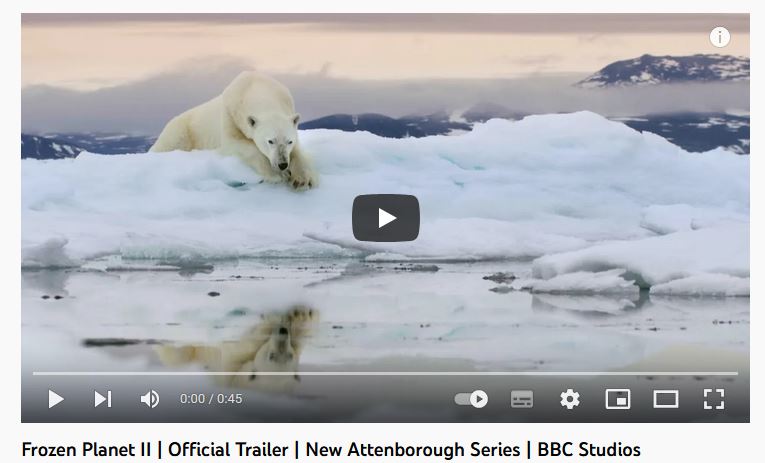
Filming of Frozen Planet II series began in 2018, which suggests it was part of Attenborough’s relentless ‘climate change’ and ‘tipping point’ messaging agenda that started in 2015 with the inception of the WWF/Netflix ‘Our Planet‘ blockbuster series and the infamous Russian ‘falling walrus’. I’m sure it’s no coincidence that the second episode of this new series (‘Frozen Ocean‘) is set to air next week, around the time that Arctic sea ice will reach its lowest extent for the year.
Frozen Planet II: Sunday [11 September], 8pm, BBC One
Penguins! Gerbils! Seals! The fluffiest (and grumpiest) cats in the world! David Attenborough returns with another epic exploration of the world’s frozen regions. One minute you’re screaming at a grizzly bear chasing a muskox calf that’s lost its parents, the next you’re weirdly sad that a polar bear can’t hunt seals because of the melting ice – and this image nails the urgent message in this incredible six-episode series. The frozen wilderness is disappearing at a faster rate than ever before, with the Arctic predicted to see ice-free summers by 2035. Each closeup shot of these amazing animals is a reminder of what the world will lose without taking immediate action. [my bold] Hollie Richardson, The Guardian, 11 September 2022
Svalbard/Barents Sea
Summers in the Arctic today bring record-breaking heat. With climate change, it is warming faster than anywhere else on Earth. It is predicted that the Arctic Ocean could become ice-free each summer by 2035, raising new challenges for polar bears. [my bold] Episode 2: Frozen Ocean.
The first part of the above snippet sounds like a general description of life in the Arctic for polar bears but it’s not: one of the scenes in this episode was shot in Svalbard (an archipelago east of Greenland, see below), which is decidely not representative of the Arctic in general.
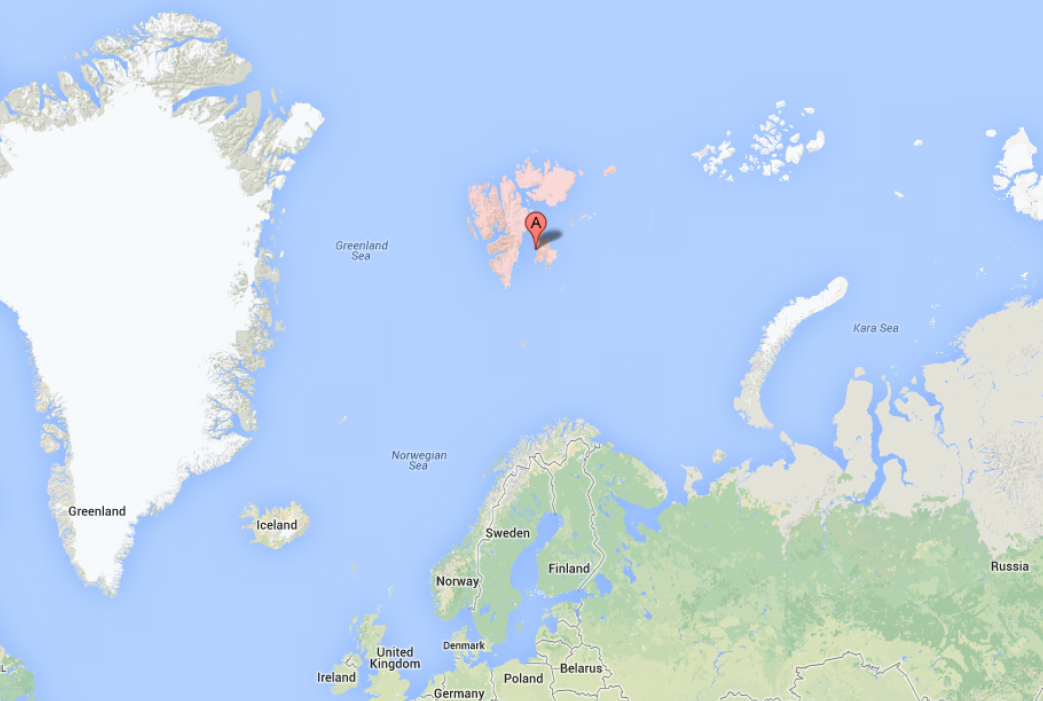
Svalbard has indeed been experiencing warm summers in recent years and this is reflected in the fact that by 2015, summer sea ice extent in the Barents Sea had retreated more than 6 times as much as it had in Southern Hudson Bay, the most southern subpopulation. The charts of summer sea ice decline from 1979-2015 below are from a paper by Eric Regehr and colleagues in 2016:

If the professed correlation between summer sea ice and polar bear health and survival stated by polar bear specialists was correct (e.g. Amstrup et al. 2007; Crockford 2017, 2019, 2022), there should be no bears left in Svalbard. This portion of the Barents Sea subpopulation especially has endured more than a decade of critically low sea ice in summer.
However, despite this dramatic decline in summer sea ice, polar bears in Svalbard are “unexpectedly” thriving, according to one of the polar bear specialists who continuously monitors their condition. During the last population survey in the spring of 2015, bears were found to be in excellent condition and many cubs were counted. As recently as spring 2022, this was still the case and a detailed study published in 2019 had this to say about the health of polar bear females in particular:
“Unexpectedly, body condition of female polar bears from the Barents Sea has increased after 2005, although sea ice has retreated by ∼50% since the late 1990s in the area, and the length of the ice-free season has increased by over 20 weeks between 1979 and 2013. These changes are also accompanied by winter sea ice retreat that is especially pronounced in the Barents Sea compared to other Arctic areas” [Lippold et al. 2019:988]
The answer to the conundrum of polar bear survival in Svalbard is that sea ice in Spring (i.e. April-May), when the bears do most their feeding, is abundant and that has not changed in recent years, as this sea ice area chart for 7 April 2020 shows:
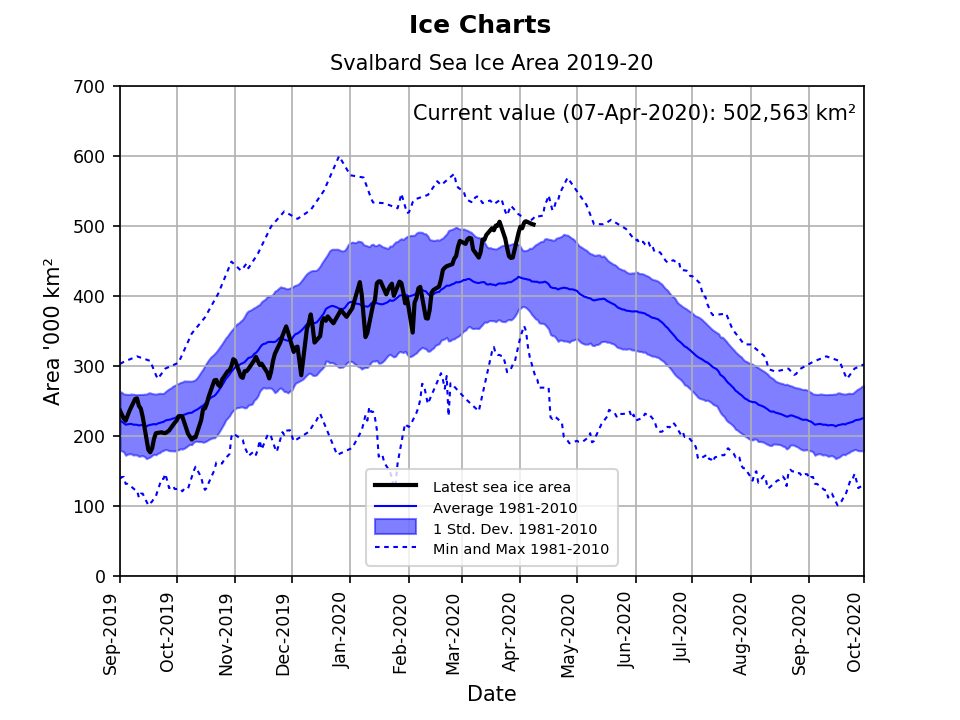
Here is the critical take-home message about polar bears in the Barents Sea:
“Despite the declining sea ice in the Barents Sea, polar bears are likely not lacking food as long as sea ice is present during their peak feeding period.” [Lippold et al. 2019:988]
Wrangel Island/Chukchi Sea
Without sea ice, more and more bears are becoming stranded on remote Arctic islands. It’s a dangerous place to be for a mother bear with cubs, surrounded by larger, predatory males. Episode 2: Frozen Ocean.
The other story about polar bears presented in this series takes place on Wrangel Island, where “…a mother polar bear finds herself stranded on a remote island full of threatening males as she struggles to feed her cubs.” Although the episode hasn’t aired yet, it’s possible to pre-emptively refute the implied narrative of a struggle for survival brought about by human-caused climate change resulting in a sea ice death spiral.
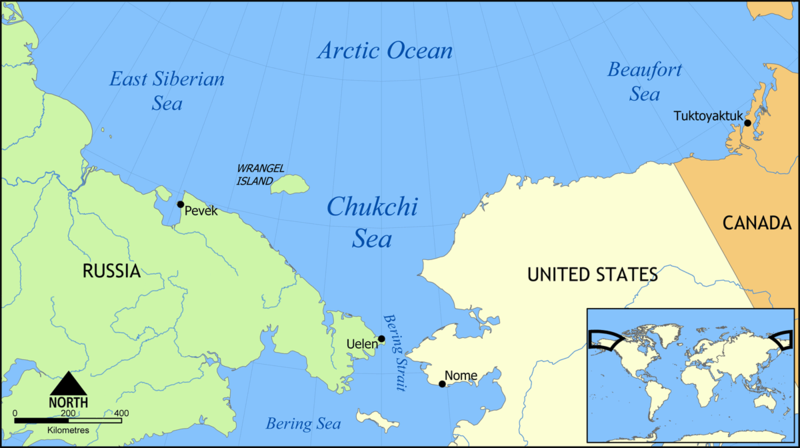
Chukchi Sea polar bears are the other subpopulation that is ‘unexpectedly’ thriving despite recent dramatic declines in summer sea ice and an increase in time spent on land during the summer (Rode and Regehr 2010; Rode et al. 2013, 2014, 2015, 2018). Chukchi Sea polar bears are abundant and in excellent condition. Wrangel Island has always been used as a summer refuge for polar bears when the sea ice retreats during the summer (and a critical denning area for pregnant bears), which means this ‘stranding’ of a mother bear and her cubs is not a new phenomenon.
And while slightly more polar bears have indeed spent about one month more on land during the 2010s, in recent years that pattern has changed. Sea ice along the coast of Chukotka and around Wrangel was very thick last summer and at 1 September this year Wrangel was still surrounded by ice (see below):
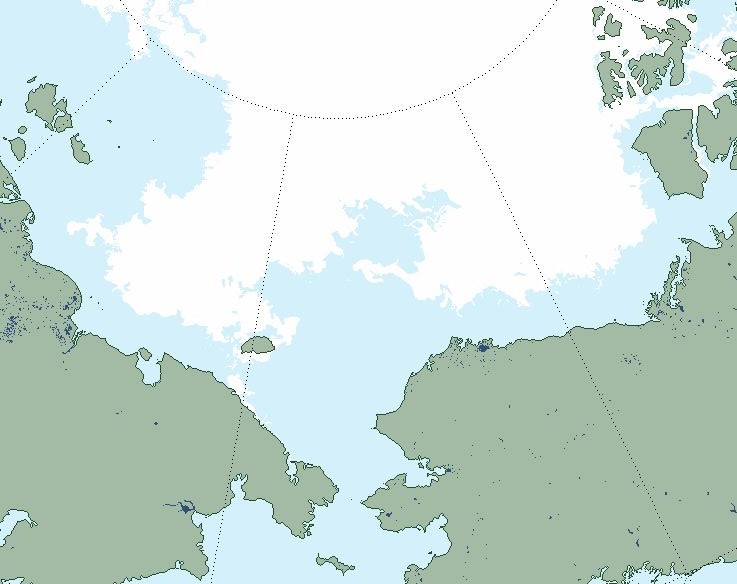
The conundrum of polar bears and seals thriving in the Chukchi Sea despite less summer sea ice is explained by the fact that primary productivity has increased since sea ice declined after 2002. Studies have shown that more sunlight reaching open water for longer periods in recent years has meant more food for the entire Arctic food chain and that these effects have been strongest in the Chukchi and Barents Seas (Coupel et al. 2019; Crockford 2021; Frey et al. 2020). More food for fish and seals has meant more food for polar bears in the spring and fatter bears mean more healthy cubs.
In other words, any suggestion in the Frozen Planet II series that Wrangel Island polar bear mothers and cubs might be struggling to survive due to lack of sea ice would not be supported by scientific data.
In conclusion, this series is more deliberate emotional manipulation meant to make viewers amenable to ‘taking action on climate change’ (whether voluntarily or via government edict), as Frozen Planet II executive producer Mark Brownlow told the BBC:
Environmental storytelling is much more engrained in this series. We get the audience invested in our characters, which we then use to communicate the message. Our harp seal sequence in Greenland is a good example. Females abandon their pups at just 12 days old, having introduced them to swimming, so they can breed again. At the point in the sequence that our female leaves her youngster – alone on a small ice floe in the middle of freezing nowhere – you’re emotionally engaged.
Then we reveal the difficult truth: due to climate change, storms are more frequent and the ice is thinning, which means many pups are being blown into the water before they are properly able to cope. It’s heartbreaking.
Never mind that harp seal abundance across the Arctic is at an all-time high because numbers in the NW Atlantic are booming or that a storm or low ice coverage at the wrong time in any year can cause high pup mortality: the BBC/Attenborough agenda demands a certain a message be told about climate change and the people involved are not about to let scientific facts get in their way. This is calculated ‘climate change’ propaganda marketed as ‘entertainment’. Buyer beware.
References
Amstrup, S.C., Marcot, B.G. & Douglas, D.C. 2007. Forecasting the rangewide status of polar bears at selected times in the 21st century. US Geological Survey. Reston, VA. Pdf here
Coupel, P., Michel, C. and Devred, E. 2019. Case study: The Ocean in Bloom. In State of Canada’s Arctic Seas, Niemi, A., Ferguson, S., Hedges, K., Melling, H., Michel, C., et al. 2019. Canadian Technical Report Fisheries and Aquatic Sciences 3344.
Crockford, S.J. 2017. Testing the hypothesis that routine sea ice coverage of 3-5 mkm2 results in a greater than 30% decline in population size of polar bears (Ursus maritimus). PeerJ Preprints 19 January 2017. Doi: 10.7287/peerj.preprints.2737v1 Open access. https://peerj.com/preprints/2737/
Crockford, S.J. 2019. The Polar Bear Catastrophe That Never Happened. Global Warming Policy Foundation, London. Available in paperback and ebook formats.
Crockford, S.J. 2021. The State of the Polar Bear Report 2020. Global Warming Policy Foundation Report 48, London. PDF here.
Crockford, S.J. 2022. The State of the Polar Bear 2021. Global Warming Policy Foundation Note 29, London. pdf here.
Frey, K.E., Comiso, J.C., Cooper, L.W., Grebmeier, J.M. and Stock, L.V. 2020. Arctic Ocean primiary productivity: the response of marine algae to climate warming and sea ice decline. 2020 Arctic Report Card. NOAA. DOI: 10.25923/vtdn-2198 https://arctic.noaa.gov/Report-Card/Report-Card-2020/ArtMID/7975/ArticleID/900/Arctic-Ocean-Primary-Productivity-The-Response-of-Marine-Algae-to-Climate-Warming-and-Sea-Ice-Decline
Lippold, A., Bourgeon, S., Aars, J., Andersen, M., Polder, A., Lyche, J.L., Bytingsvik, J., Jenssen, B.M., Derocher, A.E., Welker, J.M. and Routti, H. 2019. Temporal trends of persistent organic pollutants in Barents Sea polar bears (Ursus maritimus) in relation to changes in feeding habits and body condition. Environmental Science and Technology 53(2):984-995.
Regehr, E.V., Laidre, K.L, Akçakaya, H.R., Amstrup, S.C., Atwood, T.C., Lunn, N.J., Obbard, M., Stern, H., Thiemann, G.W., & Wiig, Ø. 2016. Conservation status of polar bears (Ursus maritimus) in relation to projected sea-ice declines. Biology Letters 12: 20160556. http://rsbl.royalsocietypublishing.org/content/12/12/20160556 Supplementary data here.
Rode, K. and Regehr, E.V. 2010. Polar bear research in the Chukchi and Bering Seas: A synopsis of 2010 field work. Unpublished report to the US Fish and Wildlife Service, Department of the Interior, Anchorage. pdf here.
Rode, K.D., Douglas, D., Durner, G., Derocher, A.E., Thiemann, G.W., and Budge, S. 2013. Variation in the response of an Arctic top predator experiencing habitat loss: feeding and reproductive ecology of two polar bear populations. Oral presentation by Karyn Rode, 28th Lowell Wakefield Fisheries Symposium, March 26-29. Anchorage, AK.
Rode, K.D., Regehr, E.V., Douglas, D., Durner, G., Derocher, A.E., Thiemann, G.W., and Budge, S. 2014. Variation in the response of an Arctic top predator experiencing habitat loss: feeding and reproductive ecology of two polar bear populations. Global Change Biology 20(1):76-88. http://onlinelibrary.wiley.com/doi/10.1111/gcb.12339/abstract
Rode, K. D., R. R. Wilson, D. C. Douglas, V. Muhlenbruch, T.C. Atwood, E. V. Regehr, E.S. Richardson, N.W. Pilfold, A.E. Derocher, G.M Durner, I. Stirling, S.C. Amstrup, M. S. Martin, A.M. Pagano, and K. Simac. 2018. Spring fasting behavior in a marine apex predator provides an index of ecosystem productivity. Global Change Biology http://onlinelibrary.wiley.com/doi/10.1111/gcb.13933/full
Rode, K.D., Wilson, R.R., Regehr, E.V., St. Martin, M., Douglas, D.C. & Olson, J. 2015. Increased land use by Chukchi Sea polar bears in relation to changing sea ice conditions. PLoS One 10 e0142213.
I remember ages ago watching some nature documentary, no idea who, but realizing how unnatural the scenes were, how they did not add up, began watching shadows differing by time of day, finally twigged to them maybe not faking it, but at least editing everything into a composite lie. Haven’t trusted or enjoyed a single one since.
Attenborough’s voice has always grated on me, but the most annoying part is the whispering, as if to not startle the animals. That fakery pretty much sums up everything else in them too.
Felix (my bold): “Attenborough’s voice has always grated on me, but the most annoying part is the whispering, as if to not startle the animals.”
–
–
I’m OK with his voice, Felix. But I’m with you 100% on the whispering. I’m not so much annoyed as I am gob smacked by how much of an idiot it makes him out to be.
Fer cryin’ out loud Sir Attenborough! You’re narrating in a frickin’ studio a continent and an ocean away. News flash! They can’t hear you!
WAFI! But look at all the money he has made.
/inner Sam Kinison
They were exposed filming ‘wild scenes’ at a local zoo. The cinematography may be spectacular but the message is false.
This is the old Disney “nature documentaries” redux. Lemmings do not jump off cliff, either.
Yes but walruses do.
The walruses were herded off by drones, just as the lemmings were herded off by people.
When freaked out by BBC drones.
BBC drones freak me out, too.
The anthropomorphism of animals in his films is pretty bad.
attenborough is an advocate, a luvvie doing films in exotic distant locations with animals as the attraction and as protagonists, I’m surprised he doesn’t do voice overs ala <a href=”https://en.wikipedia.org/wiki/Animal_Magic_(TV_series)”>Johnny Morris</a>. Portraying said animals as ‘threatened’ plays on human emotion, it is the hook and time after time people are, hooked line and sinker. it might have been clever in the beginning, as the lies grow into whoppers, the whole shebang begins to wear and wear badly, inevitably: . attenboro’ is exposed as a silly old fa*t, we all knew him to be.
Here is another negative view of David Attenborough.
https://thomashoskynsleonardblog.blogspot.com/2019/11/sir-david-attenborough-negative-racial.html
When they can’t use the truth to tell us a story about the Polar Bears then because they have an agenda to support will LIE to deceive many people who don’t have the time or interest to learn the truth on their own it becomes more important than ever to disregard it because relying on others whom you don’t know for claims you don’t check for yourself is a recipe of being used which is their fault for being LAZY about the whole thing.
It is the same way when lazy people vote for a letter D or R instead of voting for people who actually care about the community, they live in otherwise what they end up getting is a career politician who gets corrupted by older Congressional members in Washington D.C. who are already there to suck at the taxpayer’s trough which is why so many become millionaires.
It’s a very lucrative business to operate in a non-fact checked and non-audited realm. In this case the narrated product could be replayed over countless generations as long as thinking is held at a minimum and the location is as remote as possible. The Green I Love Lucy show is here.
Only 2mins into an hour long episode and he’s already bemoaning the “alarming truth”™, it’s all disappearing.
(cue ice melting sequence and melancholic music)
They have literally filmed a Polar Bear on thin ice… lol!
I suggest watching with the sound turned down, replaced with music of your choice. The images are stunning.
Try Benedictus by Karl Jenkins, this is a great recording of it:
Sun done it!
Here is definitely a hard science proof, even doc Svalgaard would not dispute.
“With data from its closest pass of the Sun yet, the ESA/NASA Solar Orbiter spacecraft has found compelling clues as to the origin of magnetic switchbacks, and points towards how their physical formation mechanism might help accelerate the solar wind.”
https://www.esa.int/Science_Exploration/Space_Science/Solar_Orbiter/Solar_Orbiter_solves_magnetic_switchback_mystery
Vuk,
I think that he might
Attenborough programmes are great. They are masterworks in field cameraship.
You just need to do three things to enjoy them properly.
1) Turn off the sound.
2) Find some nice music instead. Maybe BBC Radio 3?
3) Have googled the locations in that episode in advance so you can research the areas on your laptop when the pictures come up.
HDTV and a large screen is a must.
Don’t Google anything, Google is as bad as Attenborough. Use DuckDuckGo instead.
You are out of date, friend. DuckDuckGo WAS my browser of choice, too, a few months back, but no more! Now I only trust the Brave browser and search engine, and even then only until I learn otherwise. Things change fast on the internet.
Hah! My wife and I enjoy his shows too… with the sound off.
It kind of interferes with the flow of the show when we are both screaming at the TV over what he is saying, so we turn the sound off and enjoy the great cinematography. They do have one heck of a camera crew. First rate.
Fun fact: “Climate science” has not even understood the Arctic Amplification (AA). It has identified two mechanisms.
1. Albedo feedback. As the ice melts and gives place to the much darker sea water, less sun light is reflected warming the arctic ever faster.
The problem with this theory is that a) at low angles water is highly reflective, as Fresnel equations show. As the sun never reaches high up in the Arctic, the difference between ice and water is not that big. The other more obvious problem is b) the warming does not occur in summer, but in winter (or the prolonged cold season respectively). When there is no sun, there is no albedo effect either..
2. Lapse rate feedback. The GHE depends on the magnitude of the lapse rate. The larger the lapse rate, the larger the GHE (Note: it is one of the reasons why “back radiation” is totally irrelevant). Generally lapse rate feedback is negative, as more WV means more latent heat and a decrease of the lapse rate. In the Arctic however only the surface warms, not the troposphere higher up. Thus the lapse rate increases, strenghening the GHE so to say.
The problem is, the lapse rate increases per definition if only the surface warms. It is only a formal relation, not causation. You go from the surface warms, that increases the lapse rate, that warms the surface. It is circular reasoning.
Both theories “climate science” provides for the AA are total nonsense. The truth is far simpler. It is all about convection. Water passes on its temperature to the air and atmosphere above it, while ice insulates it. Or in other terms, it is maritime vs. continental climate. With declining sea ice, the Arctic gradually moves from a continental (winter-) climate, to a far more moderate maritime climate. Just compare Trondheim (63N, -1.3°C in Jannuary) to Yakutsk (62N, -36.9°C in Jannuary) to understand the significance.
Unsurprisingly Arctic “lapse rate feedback” occurs exactly where the ice melts..
Oh the irony
Yes, convection. The Arctic gets heat input during winter from both air and water convection. The Antarctic gets almost zero input from water convection since Antarctica almost perfectly fills the area circumscribed by the Antarctic Circle.
That convection difference is somewhat offset by the Southern Hemisphere having much more water area than the Northern Hemisphere.
Another factor is that Northern Hemisphere Summer currently happens during Perihelion (closest to the Sun) and Southern Hemisphere Summer happens during Aphelion (furthest from the Sun).
That moderates Winter in the Northern Hemisphere by keeping the land warmer. Southern Hemisphere Winter is cooler than it would be if it happened during Perihelion but they’re still not as cold as the North (except at high altitudes) due to the moderating effect of the much larger amount of ocean that stores so much heat.
Northern Summer is also moderated by the current relation of the Earth’s axis to Aphelion and Perihelion of the orbit. If Northern Summer was at Perihelion it would be much warmer due to having less ocean area to absorb the heat. If Southern Winter was at Perihelion it would also be quite a bit warmer than current conditions.
In about 13,000 years, that will be the case. Due to the land VS water makeup of the hemispheres, Earth will be overall warmer, and there’s not a thing anyone can do about it.
But before the inverse of current conditions comes along, in about 6,500 years Earth will experience Summer and Winter at the ‘sides’ of Earth’s orbit (I searched and could not find what the term is for a point halfway between apoapsis and periapsis of an orbit.) with equal insolation in each season North and South. Spring and Fall will have more pronounced differences in each Hemisphere.
Attenborough, like Al Gore, is one court case away from having a legal advisory notice placed on these alarmist ‘entertainment’ shows.
Attenbollocks.
I had BBC1 on for the news of the Queen … then there was this … every time I hear his voice these days I just switch off.
Once you start actually looking at his programs it becomes clear that he is not narrating what has been filmed, but has filmed and edited to fit his narrative.
BBC made some kind of wildlife in China program which ADV China on YouTube discovered by accident to be a fake. ADVChina is an education on what the real China is today.
is the thumb a finger?
Most children learn to count to 10 on their fingers: 1, 2, …, 10.
Hope that helps. Some, maybe, only go to 8.
Hmm!
An other way to count is backward to show to have 11 fingers:
first hand:
10,9,8,7,6 + the 5 of the other hand = 11
Any questions ? 😀
Keep on him, Susan!
As much as I had once loved Attenborough’s videos as a vehicle for my students to witness nature’s beauty, Attenborough has increasingly demonstrated, via his false narratives attached to cherry-picked videos, that his main goal is to push the public into fearing a fabricated climate collapse and persuade people into embracing a one world government as the only means of saving humanity, as documented in my video on Breaking Boundaries https://www.youtube.com/watch?v=w8IbgqVgxP8
As we uncover the truth behind Attenborough’s efforts it is really a disgusting display of dishonesty and manipulation!
Attenborough doesn’t like people. He has been a patron of the Optimum Population Trust since 2009 and they display the following comment from him prominently on their website
“All our environmental problems become easier to solve with fewer people, and harder – and ultimately impossible- to solve with ever more people”
Attenborough is going for ice free Arctic in 2035.
That would call for some serious acceleration on the melting front.
Oh, and they just found some more bears:
https://nsidc.org/news-analyses/news-stories/newly-documented-population-polar-bears-southeast-greenland-sheds-light
Here’s the latest Svalbard sea ice extent.
Uh oh, looks like an early up tick this month.
Another sign of nasty winter coming.
Many of the spruce trees in calgary are massively weighted down with seed cones this year, tops of trees looking brown because of it
I have a couple of White Spruce (just north of Ellensburg WA) — must be a widespread “mast” year.
And in the early part of the 20thC the coalport at Spitsbergen, as Svalbard was then called, was accessible for only 3 months of the year before 1920. By the late 1930s it was open for more than 7 months of the year.
Looks like the low ice levels earlier in the year allowed a lot of extra heat to escape, resulting in an earlier start to the re-freezing.
I put no stock in this kind of environmentalist slop.
How about a cartoon showing Attenborough jumping off a cliff to escape the truth?
Animals doing what they do to survive can in no way be tied to a fraud. One thing we know for sure is all animals die and climate activists can’t save them.
Arctic ice is bottoming out this equinox at four and three quarters Wadhams, most since 2007? Save twice, above four Wadhams for fifteen years. Wrap up warm
Outstanding choice. Since 2007 when Al Gore and IPCC AR4 started all the hysterical screaming and doomsday predictions, only 2009,2013 and 2014 have had more summer ice than this year. That canary is looking to be in particularly good health right now. Good news for those working in coal mines !!!
“Is that true, or did you hear it on the BBC ?”
I fail to reconcile melting ice and the impending flooding with the history of Harlech castle apparently built to be serviced from the sea and now a walk to the shore.
Please would as many UK readers of this site as possible put in a complaint to the BBC about this. It isn’t difficult to do and unless we object the BBC will continue to pump this stuff out. Just search ‘BBC complaints’ and be very objective.
Perhaps the idea from the 1970’s that more sea ice is their preferred natural environment and better for them is wrong.
Thanks for the article. On a related note, there’s this news:
https://scitechdaily.com/greenland-ice-sheet-already-reached-tipping-point-20-years-ago/
If we don’t dry up and die, we’ll drown…..